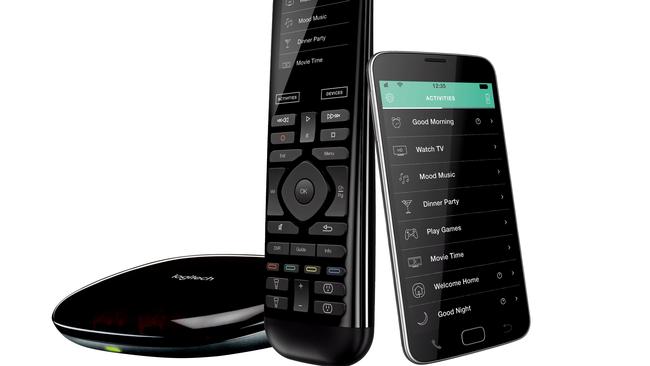Logitech Harmony and Ray Super Remote lead remote control switch
Tired of the remote-control fumble? New devices for your home entertainment system are a step in the right direction.

Main system power on. Switch to input two, power and go. Secondary control prepped and ready. Auxiliary volume cranked up to level nine on third control.
Preparing for lift-off at Cape Canaveral or to find a movie to watch on a Saturday night?
You decide.
While smart TVs were supposed to send our idiot boxes to graduate school, most of our living rooms still have cable boxes, streaming media devices, Blu-ray players, gaming consoles and sound systems — along with the remotes to control them.
Universal remotes were supposed to solve this, but their jumbled mess of buttons have long made things more difficult.
That is, if you ever figured out how to program one in the first place. Like me, you probably admitted defeat and bought an unsightly remote control basket.
It may be time to reconsider. The addition of touch screens, Bluetooth and Wi-Fi has given birth to a smarter, easier-to-use generation of universal remotes.
After testing eight, including options that use your phone, I found the new $250 Ray Super Remote to be the biggest help in my family room.
But don’t get your hopes up: outdated technology still stands in the way of a frustration-free experience and if you have newer devices you’ll lose out on features.

Not-quite-Harmony from Logitech
Sure, you can snap up an $18 universal remote, but Logitech’s Harmony line has long dominated the $70-and-up category. Why so much? These sleek remotes control up to 15 devices, don’t require programming codes and many have screens.
Over the course of three months, I tested the $112 Harmony 650, $350 Ultimate One and $489 Elite and found them to be best at single actions. The programmable Watch TV button takes care of everything I need to watch cable, including setting my TV to the HDMI 1 input. No more nagging when your visiting uncle wants to watch Judge Judy.
Unsurprisingly, of all the Logitechs, I liked the most expensive best. Unlike the other models, you program the Elite using your phone (rather than with terribly outdated PC software) and it mixes real buttons and a 2.4-inch touch screen in an incredibly comfortable design. Still, I wouldn’t buy it. No matter which Logitech I used, I ran into maddening troubleshooting issues.
It’s by and large the fault of infra-red, a technology found in most home entertainment devices. The remote sends commands via pulses of light to the boxes’ IR receivers. There are two big problems: it requires line of sight to the box and, because IR is a one-way technology, the remote doesn’t know if the box really did what it was told.
When everything isn’t lined up perfectly, things can crumble faster than a Jenga tower. Here’s an example: If you tell the television to turn on, but it is already on, it will turn off. Yet the remote will display settings as if it is on.
It isn’t Logitech’s fault that IR is an intrinsically dumb technology. But it is at fault for making it so hard for the average, non-tech-savvy person to fix the subsequent issues. On the Elite’s screen, I needed to swipe a couple of times to simply find the commonly used input and power buttons.
A Ray of hope
The Ray Super Remote from New York start-up Ray Enterprises similarly relies on IR to communicate with most items in my living room. But it was far better at providing the tools to course correct.
The Ray’s mostly touch-screen, iPhone 4-like design (below) may turn off those who prefer real buttons. But the 4.8-inch display’s colourful and adaptable menus quickly grew on me, especially when it came to set-up.
With Wi-Fi and Bluetooth built in, you program everything right on the device.
Using the touchpad to swipe around my cable box’s Excel-inspired menus was freeing and fast. The best part? When you configure it to control your cable box, it asks your TV preferences (comedy, reality and so on) and then feeds you suggestions on the remote’s screen. It immediately got me, recommending I watch or record The Parent Trap (the Lindsay Lohan remake, naturally). I wish it also suggested places to watch it on streaming services. Ray says it is working on that.
Even if you don’t use the TV listings menus, you’ll appreciate the simple interface. The main home screen lists your devices. While there, tapping on Roku, for instance, readies the streaming box, powers on the TV and changes it to the right input. If you run into trouble, unlike Logitech’s, it’s easy to get to the menus and options you need for specific remotes.
It’s far from perfect, though.
It provides the Apple TV basics, but I missed the Siri voice search of Apple’s own remote. The Ray does have a microphone, but Apple doesn’t have third-party support for Siri. Neither does Ray offer an on-remote keyboard for easy searching, like Apple’s own iOS apps.
Then there are hardware issues: its built-in battery had to be charged after four days (no AAs here) and I repeatedly hit the poorly placed physical volume buttons on the left edge.
Step away from the smartphone
The Ray looks awfully like a smartphone. So why not just use yours as a TV remote? I quickly discovered why that’s a bad idea. First rule of a great TV remote control: it should always be quickly accessible to everyone in the living room. How are you supposed to pause a gripping episode of Daredevil when you have an incoming call?
A spare tablet, old smartphone or iPod Touch is a far better choice. Most Android phones and tablets already have built-in IR blasters and remote apps.
LG’s G4 remote app worked just fine with most of my devices, but Android phone owners may prefer a free app called Peel (above right) for its design and ease of use. It provides a TV guide-like menu and allows you to set your favourite channels. Since Apple devices don’t have built-in IR, you’ll need a middleman that connects to your phone via Bluetooth or Wi-Fi, then routes the IR commands to your entertainment boxes.
I recommend the $70 Peel Pronto and its companion app over the Blumoo or Logitech Harmony Hub, each $140.
The Harmony Hub is a better option, however, if you are looking to control light bulbs, thermostats or locks. I’m not sold on the smartphone as a remote for the TV, but it’s a home run as one for the smart home. (If you’re looking for a remote that does double duty for your smart home, the $699 Savant and $475 Neeo are set to be released soon. Ray just added support for Nest and plans to add Sonos and Hue soon.)
Our remote problem is an extension of a problem as old as TV: we’re awaiting that one box to do it all. Until that or a better alternative to IR arrives, one remote that ties together all the pieces in a easy-to-use experience is our best bet. The $350 Ray, available at Amazon and the company’s website, is the closest I’ve seen yet.
Sure, it’s an expensive option that only partially solves a problem many others are working on, but I decided to take the plunge. Anyone want a used, wicker remote control basket?


